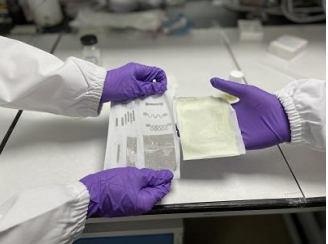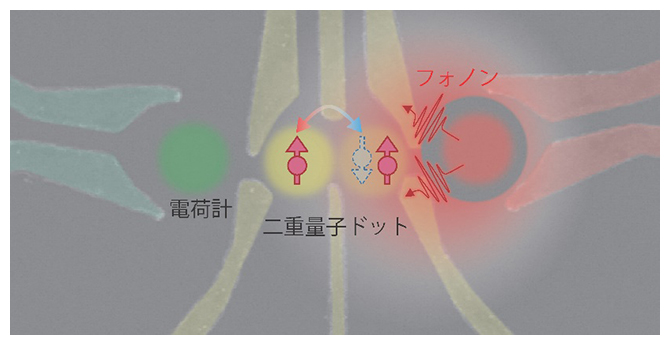2022-06-02 シンガポール・南洋(ナンヤン)理工大学(NTU)

・ NTU が、身体の挙動のエネルギーを電気エネルギーに変換する、ストレッチャブルで防水性の「ファブリック」デバイスを開発。
・ ストレッチャブルで優れた通気性・防水性と卓越した発電性能を提供する、ペロブスカイトをベースとした初の圧電効果(piezoelectricity)と摩擦帯電(triboelectricitiy)ハイブリッドエネルギーデバイス。腕、足、手、肘や靴底に取り付けて、挙動に影響すること無くエネルギーを獲得できる。
・ ポリ(ビニリデンフルオリド-co-ヘキサフルオロプロピレン)(PVDF-HPF)と、環境に優しい鉛フリーのペロブスカイト材料によるナノファイバーファブリックに、スチレン・エチレン・ブチレン・スチレン(SEBS)と銀のインクを用いてシルクスクリーンプリント作製したストレッチャブルな電極を取り付けたもの。
・ PVDF-HPF は、圧縮、折り曲げや引き伸ばし等で力が加わることで発電する圧電材料。太陽電池や LEDs での活用も期待されているペロブスカイトは脆い材料だが、PVDF-HPF との組み合わせることで機械的な耐久性とフレキシビリティーを獲得。PVDF-HPF はペロブスカイトの追加的な保護層としての役割も担い、機械特性と安定性を強化する。
・ 3cm×4cm のプロトタイプファブリックでは、継続的に手で軽く叩くことで 100 個の LEDs の点灯(2.34W/㎡の発電)と複数のキャパシタの充電を実証。洗濯、折り曲げや丸めてしわが寄っても電気特性は変わらず、5 ヶ月にわたり継続的に安定して発電した。
・ 電池容量の増加や電力需要の低減が進んでいても、ウェアラブルデバイスの電源には頻繁な電池の交換が必要。新ファブリックデバイスにより、電池寿命の延長や自己給電システム構築の可能性が期待できる。
・ ファブリックベースの環境発電プロトタイプデバイス開発は、環境にあるエネルギーの捕獲方法を調査する NTU の研究活動に基づくもの。屋根や壁に取り付けて風や雨水のエネルギーを回収するフィルムも開発している。
・ 現在、新ファブリックを使用して異なる形態のエネルギーを回収する可能性について調査中。
URL:https://www.ntu.edu.sg/docs/default-source/corporate-ntu/hub-news/ntu-singapore-scientists-develop-a-fabric-that-turns-body-movement-intoelectricity.pdf?sfvrsn=869781be_1
<NEDO海外技術情報より>
関連情報
Advanced Materials 掲載論文(アブストラクトのみ:全文は有料)
Stretchable, Breathable, and Stable Lead-Free Perovskite/Polymer Nanofiber Composite for Hybrid
Triboelectric and Piezoelectric Energy Harvesting
URL: https://onlinelibrary.wiley.com/doi/10.1002/adma.202200042
Abstract
Halide-perovskite-based mechanical energy harvesters display excellent electrical output due to their unique ferroelectricity and dielectricity. However, their high toxicity and moisture sensitivity impede their practical applications. Herein, a stretchable, breathable, and stable nanofiber composite (LPPS-NFC) is fabricated through electrospinning of lead-free perovskite/poly(vinylidene fluoride-co-hexafluoropropylene) (PVDF-HFP) and styrene–ethylene–butylene–styrene (SEBS). The Cs3Bi2Br9 perovskites serve as efficient electron acceptors and local nucleating agents for the crystallization of polymer chains, thereby enhancing the electron-trapping capacity and polar crystalline phase in LPPS-NFC. The excellent energy level matching between Cs3Bi2Br9 and PVDF-HFP boosts the electron transfer efficiency and reduces the charge loss, thereby promoting the electron-trapping process. Consequently, this LPPS-NFC-based energy harvester displays an excellent electrical output (400 V, 1.63 µA cm−2, and 2.34 W m−2), setting a record of the output voltage among halide-perovskite-based nanogenerators. The LPPS-NFC also exhibits excellent stretchability, waterproofness, and breathability, enabling the fabrication of robust wearable devices that convert mechanical energy from different biomechanical motions into electrical power to drive common electronic devices. The LPPS-NFC-based energy harvesters also endure extreme mechanical deformations (washing, folding, and crumpling) without performance degradation, and maintain stable electrical output up to 5 months, demonstrating their promising potential for use as smart textiles and wearable power sources.



